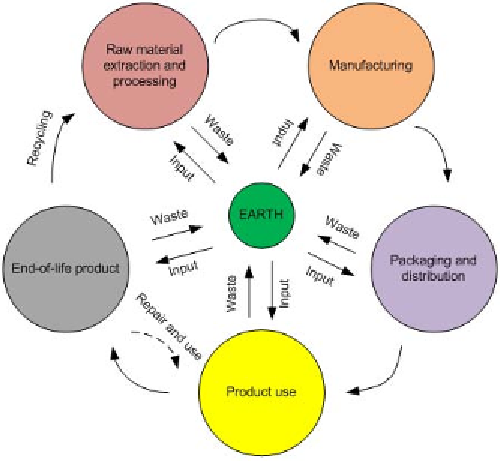Environmental Engineering Reference
In-Depth Information
Figure 3. Stages of the product life cycle-Australian Government: Department of the Environment and
Heritage (Adapted from UNEP, 2005)
life cycle approach means that we recognize how
companies' choices influence what happens at each
of these points so they can balance trade-offs and
positively impact the economy, the environment,
and society (UNEP
1
, 2004). It identifies both the
opportunities and risks of a product or technol-
ogy, all the way from raw materials to disposal.
“Life Cycle Approaches help us to find ways
to generate the energy we need without deplet-
ing the source of that energy and without releas-
ing greenhouse gases that contribute to climate
change.” (UNEP 2004, p.5)
The Life Cycle Approach is a powerful tool
to help companies' better understand the en-
vironmental effects of their technology usage,
thus providing valuable information regarding
opportunities to improve environmental perfor-
mance (Hendrickson
et al.
, 1998). LCA is also,
next to other tools, critical for technology choices,
setting technologies into a product-related chain
perspective (UNEP, 2005). The LCA assesses the
environmental impacts of a system or product from
cradle to grave throughout the full life cycle, from
the exploration and supply of materials and fuels,
to the production and operation of the investigated
objects, to their disposal/recycling (Pehnt, 2006).
This approach focuses first and foremost on (1)
compiling an inventory of relevant energy and
material inputs and environmental releases; (2)
evaluating the potential environmental impacts
associated with the identified inputs and releases,
and; (3) interpreting the results to assist companies
in making more informed decisions (EPA, 2010).
A life cycle approach is generally decomposed into
several stages (see figure 3), and most commonly
into six stages: (1) product design; (2) raw mate-
rial extraction and processing; (3) manufacture
of the product; (4) packaging and distribution to
the customer; (5) product use and maintenance;
(6) end-of-life management: reuse, recycling, and
disposal (EPA, 2010).
We developed our process perspective metric
via derivation from the Life-Cycle Approach,
focusing on the key issue as to “How effective
and efficient is Green IT during its life-cycle?”
The process metric is illustrated in Table 4. The

